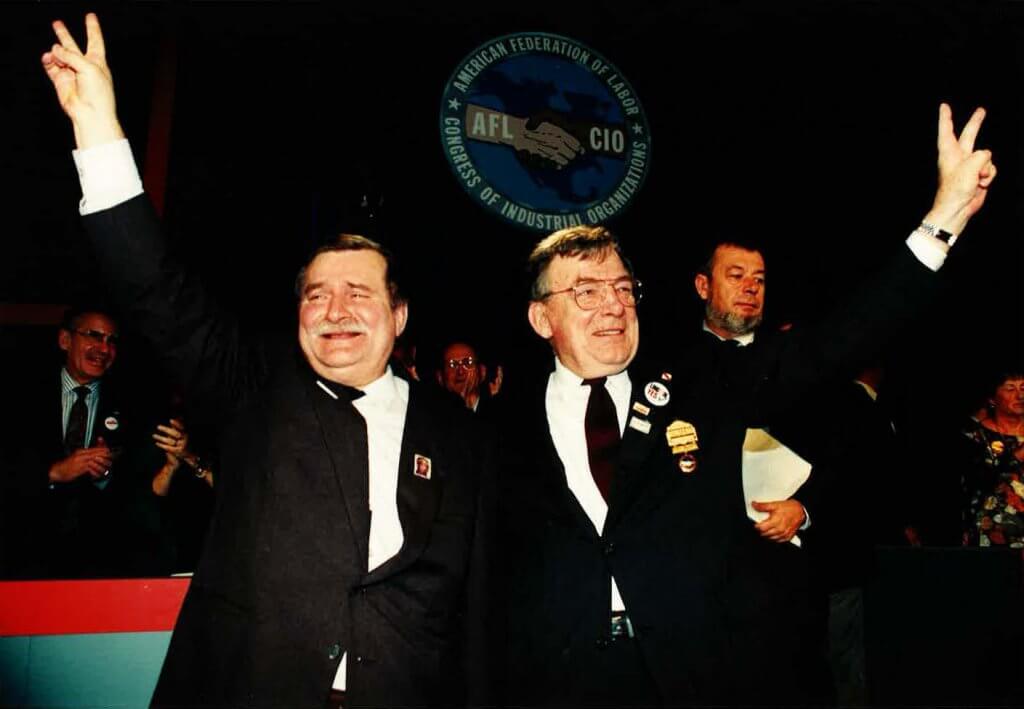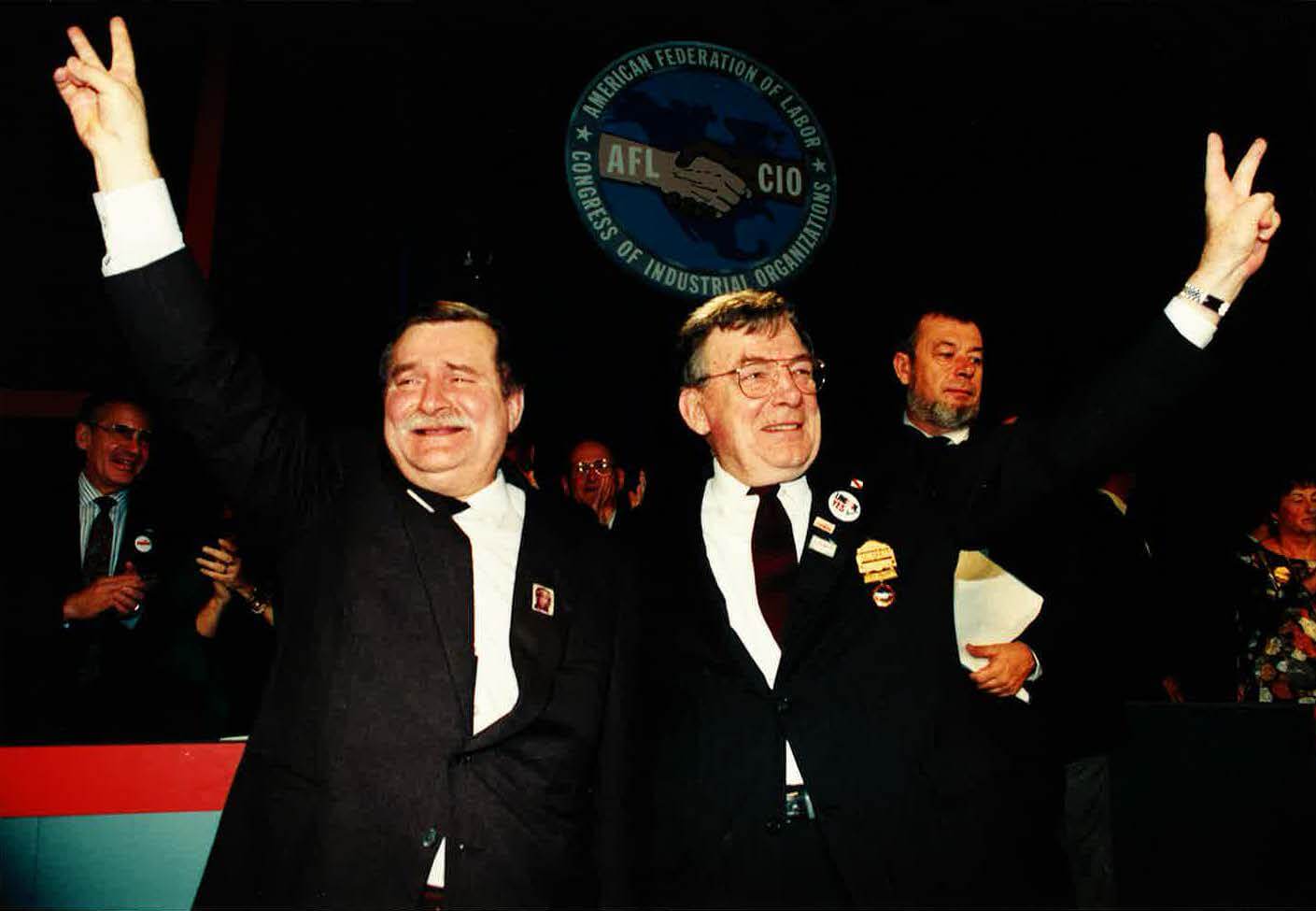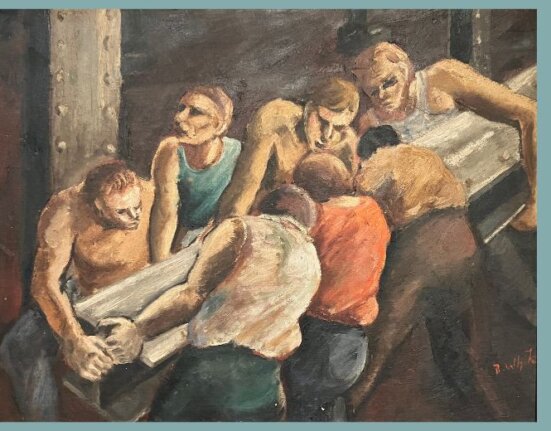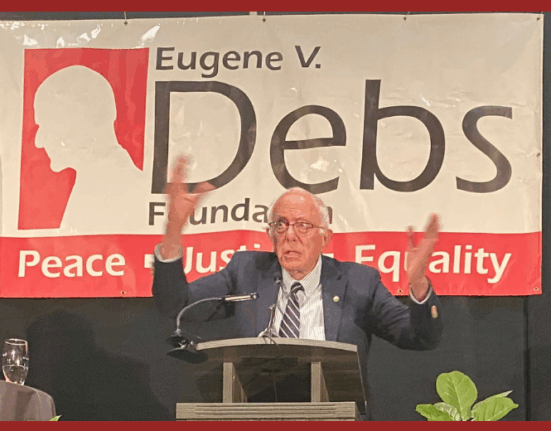Russia’s invasion of Ukraine and the death of Mikhail Gorbachev this year have sparked renewed interest in the USSR’s 1991 disintegration, a moment that officially brought an end to the Cold War.
Historians have been prominent in the many recent discussions and debates about how the demise of the Soviet Union thirty years ago set the stage for Vladimir Putin’s rise to power, the controversial expansion of NATO, and the current war in Ukraine. A US-dominated, unipolar world order, however, now appears to have run its course.
Absent from these discussions has been the small but important role played by the US labor movement—namely the leadership of the AFL-CIO—in weakening and ultimately toppling Soviet communism, inadvertently helping to usher in the era of neoliberal globalization and “free market” supremacy.
Solidarność and the AFL-CIO
The USSR’s implosion was in large part precipitated by the fall of communism in Central and Eastern Europe, which began with a dissident workers’ movement in Poland.
In August 1980, after years of turmoil in the Polish economy, approximately 17,000 workers at the Lenin Shipyard in Gdańsk went on strike. The work stoppage served as a rebuke to Poland’s communist government, with the workers demanding an autonomous trade union and more civil liberties. Within two weeks, the strikers won many of their demands, including the right to establish an independent union they named Solidarność (Solidarity).
From the beginning, Solidarność’s greatest international ally was the AFL-CIO. The Federation’s top officials, including President Lane Kirkland, were ardent anticommunists and zealous cold warriors. For decades, the AFL-CIO and many of its affiliated unions had worked closely with the US foreign policy establishment—including the CIA—to undermine leftist political movements and unions (whether communist or not) in Western Europe, Latin America, Africa, and Asia.
With the birth of Solidarność, Kirkland and his associates saw an opportunity to take their foreign crusade directly into the communist world itself.

Immediately after the Gdańsk strike, the AFL-CIO Executive Council created the Polish Workers’ Aid Fund, raising $100,000 from its affiliated unions over the next year to supply Solidarność with office equipment. Tom Kahn, a key official in the AFL-CIO’s international affairs department who ran the aid fund, openly advocated for “the dismantling, by non-nuclear means, of the Communist system.”
On December 13, 1981, recognizing the potential threat posed by Solidarność and its stridently anticommunist foreign patrons, Poland’s head of state declared martial law, banning the union and arresting its leader, Lech Wałęsa.
Five days later, Kirkland met with President Ronald Reagan at the White House to discuss the situation in Poland. The meeting was only months after Reagan had effectively declared war on organized labor by firing over 11,000 striking air-traffic controllers. “Well, at least we have something we can agree on,” Reagan joked upon greeting Kirkland, a reference to their shared anticommunism.
Kirkland urged the US president to impose crippling sanctions on Poland and the Soviet Union, including calling in all $25 billion of Polish debt to Western banks. But following the advice of Secretary of State Alexander Haig, who favored a softer approach, Reagan announced relatively mild sanctions. The US government even paid off $71 million that Poland owed to American banks, concerned that allowing default would have negative ramifications on world financial markets.
An irate Kirkland described the administration’s response as “unacceptably weak,” complaining that “bankers and businessmen” were running US foreign policy instead of genuinely committed cold warriors. “In effect, President Reagan told the Soviets to disregard his tough talk,” Kirkland said.
Haig’s approach ultimately yielded results, however, with the Polish government releasing Wałęsa in November 1982 and ending martial law in July 1983—but Solidarność remained officially banned.
The CIA and the National Endowment for Democracy
Though Kirkland and Reagan had differed on how best to respond to martial law in Poland, they agreed that the United States needed step up assistance to Solidarność. Partnering with the New York-based Committee in Support of Solidarity, the AFL-CIO’s Polish Workers’ Aid Fund continued sending hundreds of thousands of dollars to the union in the early 1980s via an office in Brussels.
The CIA also got in on the action, spinning a byzantine web of financial channels to secretly transmit money to Solidarność—secret because public awareness of such a link would undermine the union’s legitimacy as the authentic voice of Polish workers. The operation was so covert that, at least according to CIA sources, the union’s leaders were largely unaware they were being supported by the spy agency at all. Over the course of five years, Solidarność received an estimated total of $10 million in funds that originated with the CIA, according to historian Gregory Domber.
An odd assortment of US neoconservatives and anticommunist social democrats—many of whom ran in the same circles as Kirkland and Kahn—came to believe that it would be far more efficient if Washington could bankroll Solidarność out in the open, and free from any association with the CIA and its bad reputation.
To this end, in 1983, the Reagan administration and AFL-CIO teamed up to convince Congress to establish a new, quasi-private foundation to provide US government funds to anticommunist civil society organizations abroad, including unions.
AFL-CIO officials lobbied Congress to pass the bill creating what came to be called the National Endowment for Democracy (NED). Their strongest support came from anti-union Republicans like Senator Orrin Hatch of Utah. Only a few years earlier, Hatch had helped defeat legislation that would have made it easier for US workers to unionize. But he advocated more federal funding for labor’s international activities.
“The AFL-CIO in general has foreign policy positions to the right of Ronald Reagan,” an aide to Hatch told the Washington Post. Though the senator had to do “considerable soul-searching before he decided to deal with the devil,” he was impressed by the Federation’s “tremendous leverage for political activity compared to, say, CIA covert operations, which often fail,” the aide said.
The NED went into operation in 1984, with the AFL-CIO’s international arm—then called the Free Trade Union Institute, but today known as the Solidarity Center—becoming one of its core grantees. Each year between 1984 and 1988, the AFL-CIO gave an average of $300,000 in NED grants to Solidarność’s Brussels office, accounting for two-thirds of the office’s budget. In total, the NED provided slightly less than $10 million to Polish opposition groups in the mid- to late 1980s, with around $4 million moving from the AFL-CIO to Solidarność.
The New York Times noted in 1986 how the NED “resembles the aid given by the Central Intelligence Agency in the 1950’s, 60’s and 70’s to bolster pro-American political groups,” with the main difference being that the NED operated out in the open. “It would be terrible for democratic groups around the world to be seen as subsidized by the CIA,” NED President Carl Gershman—an ally of Kirkland and Kahn’s—explained, arguing that overt funding to anticommunists abroad was smarter politics. “We saw that [covert funding] in the 60’s, and that’s why it has been discontinued. We have not had the capability of doing this, and that’s why the endowment was created.”

The Fall of Soviet Communism
In the summer of 1988, with Poland’s state-run economy in ongoing crisis, Solidarność led a wave of mass strikes to channel worker discontent. The work stoppages were financially sustained with help from the NED and AFL-CIO. Forced to the negotiating table, the Polish government agreed the following year to unban the union, create a new bicameral legislature, and hold a semi-free election.
Solidarność established a political wing to run candidates for every seat in the legislature. In the run-up to the 1989 election, the union continued receiving funds from the NED/AFL-CIO to support its campaign. When the election was held on June 4, Solidarność shocked the world by winning all but one of the seats its candidates were competing for, thus taking control of the Polish government. It was Eastern Europe’s first noncommunist government since the end of World War II.
Within months of Solidarność’s electoral victory, the Berlin Wall would come down, the communist governments in Czechoslovakia and Romania would be toppled, and Bulgaria and Hungary each announced free elections for the following year that would see the communists defeated.
Past efforts by Eastern Bloc countries to break away from the USSR’s orbit had been forcibly stopped by Soviet leaders sending in the Red Army. But in 1989, the Soviet Union’s reformist leader, Mikhail Gorbachev, refused to intervene.
By October 1990, East and West Germany were reunified through a treaty. Suddenly, the countries of Central and Eastern Europe were no longer satellites of the USSR. It was widely recognized that all of this began in Poland with the steadfast opposition of Solidarność.
Because they had strongly supported the underground Polish union throughout the 1980s, AFL-CIO leaders received some of the credit for bringing down communism in the Eastern Bloc. Taking a victory lap in December 1989, Kirkland called the situation “a vindication of our central belief in free and democratic trade unionism and our shunning of any contacts with unions created by state power.”
Meanwhile, change was also brewing within the Soviet Union itself. In 1989, hundreds of thousands of coal miners in parts of Ukraine, Siberia, and Komi went on strike, demanding the limited market reforms promised by Gorbachev (“perestroika”) be fully implemented—what some observers called “perestroika from below.”
A group of striking miners in the far-northern town of Vorkuta telegrammed the AFL-CIO asking for help, noting the Federation’s “world fame in the struggle for the rights of workers.” Kirkland sprang into action, assembling a delegation that would include himself, American Federation of Teachers president Al Shanker, and United Mine Workers president Richard Trumka to go visit the Soviet strikers. Not surprisingly, the Soviet embassy in Washington denied their visa applications, and the visit never materialized.
But in the spirit of openness (“glasnost”), Gorbachev allowed a delegation of nine Soviet miners who were involved in the strikes and had formed their own independent union to travel to the United States for a month-long visit in early 1990. Hosted by the AFL-CIO, the delegates toured multiple states and met with various US unionists and officials, making sure to state that they were not seeking to overthrow the Soviet government, only to reform it.
Whatever the intentions of the coal miners, their strikes were part of a larger rebellion inside the USSR. The collapse of communism in the Eastern Bloc only gave encouragement to nationalist movements in several Soviet republics, including Ukraine and Russia itself, to demand independence from the communist government in Moscow.
Not surprisingly, the NED championed these nationalist opposition movements, channeling funds to separatist groups in the Baltics, Armenia, Ukraine, and Russia in the years prior to the breakup of the USSR. In 1991, Washington Post columnist David Ignatius attributed “the great democratic revolution that has swept the globe” to “a network of overt operatives who during the last 10 years have quietly been changing the rules of international politics. They have been doing in public what the CIA used to do in private—providing money and moral support to pro-democracy groups, training resistance fighters, working to subvert communist rule.”
The AFL-CIO, Ignatiuis wrote, was especially deserving of high praise for expertly channeling NED funds to Solidarność throughout the 1980s. “The CIA old boys spent a generation fantasizing about this sort of global anti-communist putsch. But when it finally happened, it was in the open,” Ignatius explained. NED cofounder and dedicated “democracy-promoter” Allen Weinstein agreed, telling Ignatius that “A lot of what we do today was done covertly 25 years ago by the CIA.”
By late 1991, with multiple republics seceding from the USSR and after having barely survived an attempted coup, Gorbachev threw in the towel. On Christmas Day, he announced his resignation and the dissolution of the USSR.
Shock Therapy
The collapse of Soviet communism opened the door to drastic global economic change. A week after the Berlin Wall fell, Solidarność leader Lech Wałęsa was in Washington, where he was the guest of honor at the AFL-CIO’s biennial convention. There, he thanked the delegates for being “our most steadfast allies in the trade union struggle for human freedom.”
Despite high hopes, the electoral victory of Wałęsa’s Solidarność in 1989 led to further economic deprivation for Poland’s working class. The country still owed $40 billion in debt, and inflation climbed as much as 600 percent.
Now in power, Solidarność leaders begged the West for a sorely needed bailout, but the US government, International Monetary Fund, and World Bank would only agree to provide substantial assistance if the new government took dramatic steps to rapidly privatize Poland’s state-managed economy. Speaking at the AFL-CIO convention that November, Wałęsa explained that Poland was “swimming chained hand and foot, trying to summon all of our energy just to make it safely ashore. And on the shore, there is a cheering crowd of people who offer us their admiration instead of simply throwing a life belt.”
Taking advice from Harvard economist Jeffrey Sachs, the Solidarność-led government implemented “shock therapy”—transitioning from a socialist economy to a capitalist one practically overnight. State-run industries like mines, factories, and shipyards were quickly sold off to private firms, resulting in mass layoffs.
In exchange for embracing the “free market,” the International Monetary Fund provided Poland with some debt relief and the White House promised $1 billion in aid. Sachs predicted the rapid privatizations would lead to temporary pain in the Polish economy, followed by a robust recovery.
But such a recovery did not happen. In the years after shock therapy was introduced, unemployment in Poland soared to 20 percent (higher for younger workers), poverty increased, and industrial output declined. The standard of living for many working-class Poles became worse than it had been under communism.
The same pattern played out in post-Soviet Russia under Boris Yeltsin, but with an even more extreme version of shock therapy. Virtually in an instant, price controls and trade restrictions were lifted, and hundreds of thousands of state-owned companies were devoured by corrupt businessmen and venture capitalists. In only a year, the Russian middle class was decimated, with millions losing their life savings and a third of the population being pushed into poverty.
As many observers have noted, these severe social and economic disruptions helped pave the way for Vladimir Putin’s rise to power.
Kirkland called on Washington to carry out a “Marshall Plan” for Eastern Europe and the Soviet Union by providing generous amounts of aid to the former communist countries in order to transform them into prosperous capitalist democracies with social welfare policies, robust business regulations, and strong unions.
His argument fell on deaf ears.
The foreign policy apparatus, Treasury Department, and international financial institutions were controlled by neoliberal ideologues who contended that the implosion of world communism signaled nothing less than the total victory of unfettered capitalism. According to the neoliberal vision, all that organized labor traditionally championed—social welfare, corporate regulations, a strong public sector, and collective bargaining itself—were nothing more than pesky economic “inefficiencies” that would need to be done away with at the earliest opportunity.
Aftermath
For decades, the US foreign policy establishment had been all too eager to partner with labor leaders like Kirkland when they were preaching anticommunism. But now that the Soviets were out of the picture and the time had come to shape a post-Cold War global economy, the AFL-CIO’s advice on international affairs was suddenly being ignored.
While AFL-CIO leaders had been busily waging the Cold War abroad, back at home, the US labor movement was in a steady decline in the face of unchecked union busting, corporate restructuring, and the increased mobility of capital. The 1980s were especially bad, with union density falling from 21 percent to 16 percent while real wages stagnated and income inequality skyrocketed.
In the latter years of the 1980s, the AFL-CIO tried to counteract falling union density with a series of TV commercials where Hollywood actors expressed their support for the labor movement through the slogan, “Union Yes.” During the week of Thanksgiving in 1989, Wałęsa—who had just spoken at the AFL-CIO convention—appeared before tens of millions of US television viewers for a 30-second ad paid for the by the AFL-CIO.
Sporting a “Union Yes” lapel pin, the Solidarność leader looked into the camera, speaking in Polish with English subtitles. “Please continue your support for us in Poland and support unions in the United States,” he said. Then, switching to English, Wałęsa concluded his message by urging Americans to “say ‘union yes!’”

But obviously an ad campaign could not stop the anti-worker trends of deregulation, trade liberalization, and offshoring that only intensified upon the end of the Cold War. Kirkland and the AFL-CIO leadership struggled to adapt to these changing global economic realities. This was especially evident than in the Federation’s failure to stop passage of the North American Free Trade Agreement (NAFTA), which created the largest “free trade” bloc in the world.
In the wake of NAFTA, in 1995, a group of frustrated US union presidents took the unprecedented step of forming an opposition slate to challenge Kirkland and the existing AFL-CIO leadership for control of the Federation. Facing this challenge, an embittered Kirkland resigned that August. A few months later, the “New Voice” slate, led by John Sweeney of the Service Employees International Union, won leadership of the AFL-CIO on a promise to focus on organizing workers at home.
Four years later, Kirkland died of lung cancer. Buried at Arlington National Cemetery, he was remembered and celebrated more for his anticommunist internationalism than for any particular labor advocacy at home. Among those who eulogized the former AFL-CIO president was his old friend Henry Kissinger. “The cause of freedom was his mission,” Kissinger said, “opposition to totalitarianism his vocation.”
President Bill Clinton, who had offered to make Kirkland ambassador to Poland, called him a “catalyst for international democracy.” Neoconservative commentator Ben Wattenberg referred to Kirkland as a “five-star general of the Cold War” and opined that “during the decades of the Cold War it was the AFL-CIO that was the most stalwart institutional bastion of anti-communism in America.”
A small cohort of labor officials like Kirkland had been important promoters of US Cold War foreign policy, but their relentless pursuit of an international anticommunist crusade ultimately left the labor movement unprepared for the shock and awe of capitalist reorganization after the Soviet Union’s demise.







